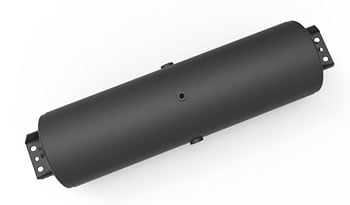How Much CFM Do I Need To Run Air Tools? – CFM Chart

Knowing how much CFM you need in an air compressor to operate your air tools can be tricky. Too little CFM and you won’t be able to run your tools continuously—or at all—and too much CFM could mean you’ve overspent on your air compressor!
We’ve developed this helpful air tool consumption chart to help you find the air compressor that’s right for you. But before we get into the CFM consumption chart, let’s talk about why CFM matters…
Pneumatic Tool CFM Requirements
Every pneumatic tool specifies how much CFM, or “Cubic Feet Per Minute” is required for proper operation; every air compressor specifies how much CFM it can produce. CFM represents the volume of air produced by your air compressor or required by your air tool.
Your tools’ CFM requirements give you an idea of what you need your air compressor to do, but it’s not enough to match the air tool’s rating and the compressor’s rating 1:1. This article will help you better understand how many CFM you need to run your air tools.
Your tools’ CFM requirements give you an idea of what you need your air compressor to do, but it’s not enough to match the air tool’s rating and the compressor’s rating 1:1. This article will help you better understand how many CFM you need to run your air tools.
Continuous vs. Intermittent Use
Air tools need a CFM that matches the manufacturer’s guidelines, but what air tool you have and how you use them matters. For example, if you’re using an impact wrench, are you:
- continuously holding the trigger down while you work, or
- using it in quick bursts with short breaks in between use, allowing the air compressor to catch up?
Do you use tools for lengthy periods? Or are your tools only used for a few minutes here and there? These are the types of questions you must ask yourself when determining your CFM needs.
If your application requires you to run air tools for an extended length of time, an air compressor with a 100% duty cycle is recommended so you can operate your tools continuously.
By contrast, tools only used intermittently may be able to get away with a less powerful air compressor that uses an air receiver tank, which may save you money.
Multiple Tools
Another common scenario that impacts CFM requirements is using multiple tools at once. Running more than one tool at a time can be a highly efficient way to get things done, especially when two or more operators are working on a single job. However, if you’re running multiple tools at the same time, you’ll need to combine the CFM requirements of each of the tools that will be running to determine your total CFM requirement.
For example, let’s say your team uses the same air compressor to power a ½” drill that requires 30 CFM and a grinder that requires 60 CFM. If you use these tools simultaneously, you will add 30 CFM + 60 CFM for a total demand of 90 CFM. You would therefore need an air compressor that can reliably produce 90 CFM of air.

Air Receiver Tanks
Air receiver tanks are another factor you should consider when determining your CFM needs. Many air compressors require an air receiver tank—in fact, this is always the case with reciprocating air compressors, which need an air receiver tank and can only produce full air power until the tank runs out of stored air.
In some scenarios, air receiver tanks can help a lower CFM air compressor keep up with a higher CFM demand and can be a good strategy when you don’t want to invest in a higher CFM air compressor. Air receiver tanks on service trucks can vary from 5 gallons to over 100 gallons.
Air Tool Consumption Chart
What does this mean for you? We’ve put together a helpful air tool consumption chart to help give you an idea of how many CFM you need to run your air tools. We’ve also included:
- Six tips for choosing an air compressor
- The average CFM at load (100% duty cycle)
- Recommended rotary screw air compressors based on your CFM needs
Here’s a sneak peek:
| 30-40 CFM Air Compressor @100% Duty Cycle, 90 psi |
60-70 CFM Air Compressor @100% Duty Cycle, 90 psi |
90-100 CFM Air Compressor @100% Duty Cycle, 90 psi |
|---|---|---|
| ¾” impact wrench | 1” impact wrench | #5 spline impact wrench |
| Air hammers | Sanders | Pneumatic saws |
| Die grinders | Vertical & angle grinders | 90 lb pavement breaker |
| Ratchets | 60 lb pavement breaker |
To view the rest of the info, download our full air tool consumption chart here!
VMAC’S Rotary Screw Advantage
Depending on the product, VMAC air compressors deliver anywhere from 30 to 110 CFM at 100% duty cycle, so you’ll never have to wait for air. Most VMAC air compressors also don’t require a bulky air receiver tank, thanks to the rotary screw technology, which allows them to operate at max efficiency 100% of the time. VMAC air compressors are lighter and smaller, and you’ll get jobs done faster, which improves your productivity and profits.
Explore your air compressor options
Learn more about choosing a mobile air compressor

